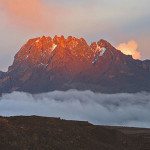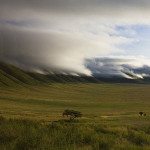 Portrait of Kilimanjaro porter from the Chagga tribe
Portrait of Kilimanjaro porter from the Chagga tribe
Photo: Thomson Safaris guest, JedsPics.com
We often talk about how the Chagga people have traditionally lived on and around the slopes of Kilimanjaro. But they haven’t always lived there; according to their own oral traditions, their people either sought out, or were driven towards, the fertile slopes of Kilimanjaro around 1500 AD, where they’ve remained ever since.
More stringent research places their migration towards the mountain a couple hundred years earlier, around 1300 AD, but before that, little evidence of permanent settlements on Kili exists. Oral traditions bear this out; according to Chagga myth, when they arrived, the mountain was unpopulated.
But in a land like Tanzania—where proto-human bones dating back nearly 2 million years have been found, indicating mankind’s presence in the region even before we fully were “mankind”—it’s hard to believe such a fertile place would remain essentially undiscovered for so long.
And indeed, there are traces left behind by much earlier inhabitants of Kilimanjaro. We don’t have much concrete evidence about Kilimanjaro’s earliest residents, but we know they were there, and we can piece together a decent amount about how they lived.
Several primitive stone bowls and stone rings have been found on the lower slopes of Kilimanjaro, which—thanks to carbon dating—prove that man has lived on the mountain’s slopes since at least 1000 BC.
Crude obsidian blades and tools have been found near some of these, but the bowls and tools have never been found in large concentrations, indicating the inhabitants were likely hunter-gatherers, as opposed to permanently-settled farming communities. Enough of the artifacts have been discovered in various places around the mountain to indicate these people weren’t just passing through; they may not have built totally-settled communities, but they called Kilimanjaro’s slopes home for a significant stretch of time.
The obsidian blades tell us even more. Geologists don’t know of any deposits of the distinctive black stone (barring those near Kili’s summit) nearby. In fact, the nearest outcropping of the rock is over 100 miles away, in Kenya. This has led them to posit that these early inhabitants probably migrated for some distance before settling on Kilimanjaro. The theory makes a lot of sense; the mountain’s rich volcanic soil provides abundant edible plants, materials for shelter, and fodder for grazing animals that could be hunted. To those living a hunter-gatherer lifestyle, the mountain’s fertile slopes must have felt like the proverbial jackpot.
But of course there’s another possible answer: whoever these people were, they may have been the TRUE first summiteers of Kili.
Until more definitive evidence proves otherwise, we’re choosing to believe that version of the story!






